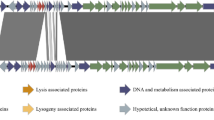Abstract
Recombinant (attenuated) bacteria Bordetella pertussis that contains a knock-out mutation in dnt gene and produces a nontoxic derivative of pertussis toxin have been constructed. Immunological properties of mutant bacteria B. pertussis of KS strain have studied. It is demonstrated that recombinant bacteria B. pertussis of KS strain devoid of activity of dermonecrotic toxin protect the structure of mutant dnt genes upon cultivation on selective nutrient media and long-term exposure in organisms of laboratory animals. The intranasal immunization of mice with live B. pertussis bacteria of the attenuated KS strain protects animals from infection with virulent strain of pertussis pathogen, which can be comparable with an OSO-3 industrial standard sample.
Similar content being viewed by others
References
Instruktsiya po otboru, proverke i khraneniyu shtammov B. pertussis dlya izgotovleniya koklyushnoi vaktsiny i koklyushnogo komponenta assotsiirovannykh vaktsin (Instruction to Selection, Testing, and Storage of B. pertussis Strains for Preparation of Pertussis Vaccine and Pertussis Component of Associated Vaccines), Moscow, 1987.
Maniatis, T., Fritsch, E. F., and Sambrook, J. Molecular Cloning, Cold Spring Harbor, New York: Cold Spring Harbor Lab. Press, 1982. Translated under the title Metody geneticheskoi inzhenerii. Molekulyarnoe klonirovanie Moscow: Mir, 1984.
Miller, J., Experiments in Molecular Genetics, New York: Cold Spring Harbor, 1982. Published under the title Eksperimenty v molekulyarnoi genetike, Moscow: Mir, 1984.
Sinyashina, L.N., Nechaeva, E.V., Amelina, I.P., and Karataev, G.I., Zh. Mikrobiol. Epidemiol. Immunobiol., 2009, no. 6, pp. 24–26.
Chuprynina, R.P., Ozeretskovskii, N.A., and Alekseeva, I.A., Biopreparaty, 2001, no. 3, pp. 19–22.
Centers for Disease Control and Prevention. Pertussis United States, 1997–2000, Morbid. Mortal Wkly Rep. 2002, vol. 51, pp. 73–76.
Diavatopoulos, D.A. Craig, A., et al., PLOS Pathogens, 2005, vol. 1, pp. 373–383.
Guiso, N., Najmkepo, E., Vié le Sage, F., et al., Vaccine, 2007, vol. 25, pp. 1390–1397.
Gustafsson, L., Hallander, H.O., Olin, P., et al., N. Engl. J. Med., 1996, vol. 334, pp. 349–355.
Hewlett, E.L., Sauer, K.T., Myers, G.A., et al., Infect. Immun., 1983, vol. 40, pp. 1198–1203.
Horiguchi, Y., Nakai, T., and Kume, K., Infect. Immun., 1991, vol. 59, pp. 1112–1116.
Horiguchi, Y., Senda, T., Sugimoto, N., et al., J. Cell Sci., 1995, vol. 108, pp. 3243–3251.
Kashimoto, T., Katahira, J., Cornejo, W.R., et al., Infect. Immun., 1999, vol. 67, pp. 3727–3732.
Kume, K., Nakai, T., Samejima, T., and Sugimoto, C., Infect. Immun., 1986, vol. 52, pp. 370–377.
Mattoo, S. and James, D., Clin. Microbiol. Rev., 2005, vol. 18, pp. 326–382.
Mielcarek, N., Debrie, A.-S., Raze, D., et al., PLOS Pathogens, 2006, vol. 2, pp. 662–670.
Mooi, F.R., van Loo, I.H., and King, A.J., Emerg. Infect. Dis., 2001, vol. 7, pp. 526–528.
Parkhill, J., Sebaihia, M., Preston, A., et al., Nat. Genet., 2003, vol. 35, pp. 32–40.
Pizza, M., Covacci, A., Bartoloni, A., et al., Science, 1989, vol. 246, pp. 497–500.
Pullinger, G.D., Adams, T.E., Mullan, P.B., et al., Infect. Immun., 1996, vol. 64, pp. 4163–4171.
Purdy, K.W., Hay, J.W., Botteman, M.F., and Ward, J.I., Clin. Infect. Dis., 2004, vol. 39, pp. 29–30.
Schmidt, G., Goehring, U.M., Schirmer, J., et al., J. Biol. Chem., 1999, vol. 274, pp. 31875–31881.
Stevenson, A. and Roberts, M., FEMS Immunol. Med. Microbiol., 2003, vol. 37, pp. 121–128.
Stibitz, S. and Miller, J.F., in Molecular Genetics of Bacterial Pathogenesis, Miller, V.L., et al., Ed., Washington, 1994, pp. 407–422.
Author information
Authors and Affiliations
Additional information
Original Russian Text © L.N. Sinyashina, L.S. Sinyashina, E.G. Semin, I.P. Amelina, G.I. Karataev, 2010, published in Molekulyarnaya Genetika, Mikrobiologiya i Virusologiya, 2010, No. 3, pp. 31–36.
About this article
Cite this article
Sinyashina, L.N., Sinyashina, L.S., Semin, E.G. et al. Construction of genetically attenuated bacteria Bordetella pertussis devoid of dermonecrotic toxin activity that produces modified nontoxic form of pertussis toxin. Mol. Genet. Microbiol. Virol. 25, 124–131 (2010). https://doi.org/10.3103/S0891416810030067
Received:
Published:
Issue Date:
DOI: https://doi.org/10.3103/S0891416810030067



